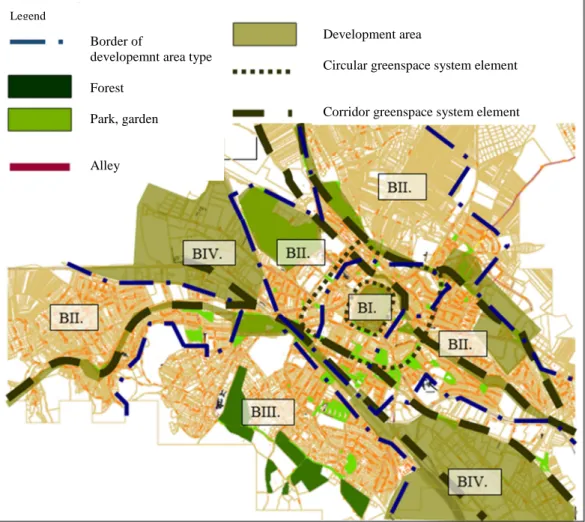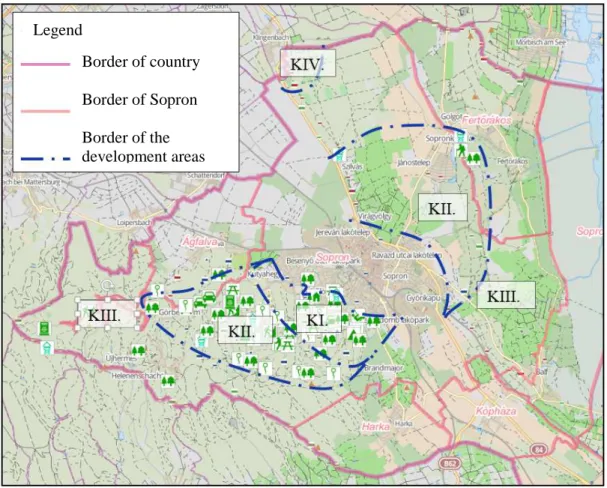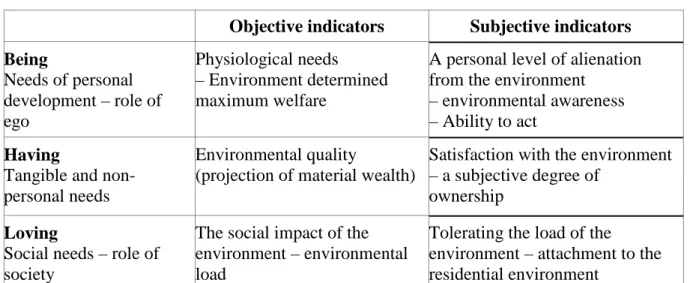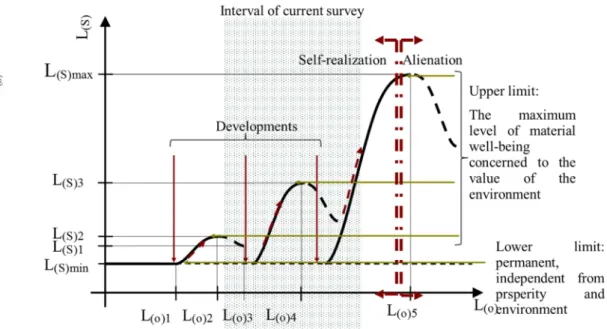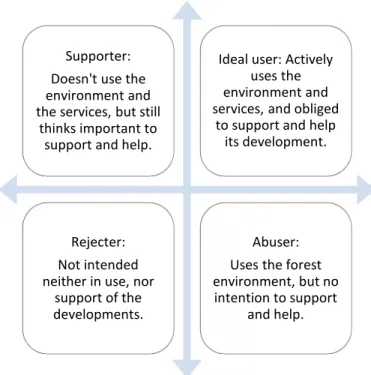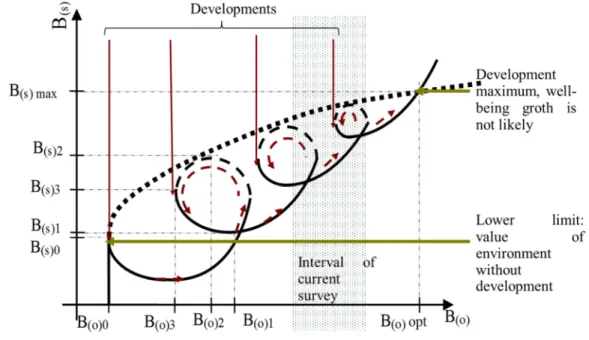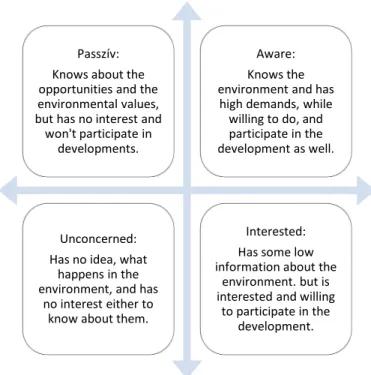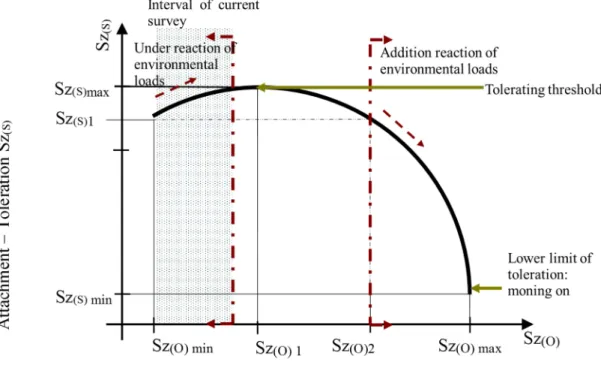Doctoral thesis
DEVELOPMENT OF COMMUNITY SPACES IN FORESTS, AND THEIR IMPACT
ON QUALITY OF LIFE
University of West-Hungary, Doctoral School of Roth Gyula Forestry and Wildlife management, Forest value assessment (E3) Program
Author: Nagy, Gabriella Mária
Supervisor: Dr Héjj, Botond
Sopron
2015
Doctoral School: Roth Gyula Forestry and Wildlife management Leader: Prof Dr Faragó Sándor
Programme: Forest value assessment (E3) Program Deputy programleader: Prof. Em. Lett Béla
Supervisor: Dr. Héjj Botond
1. GOALS, HYPOTHESES
In my research my goal was to examine and develop such tools, which can be used in the decision making process of the complex strategical development of green fields, while keeping in mind the green field environment of the settlement as well as the satisfaction of the demands of the population, both from professional and personal point of view. I feel important that the planning methods of landscape architecture and forestry get closer to each other, learn about each other’s tools and concepts as they both work on the same field.
In my work the set goals were:
• Overview of quality of life models in order to adopt them into environmental assessment, and implement them in practice on local level.
• Survey the green spaces and greenspace system of Sopron, and define the directions of development.
• Assess outskirt forests as parts of the greenspace system of the city and as recreational tourist destinations, measuring the touristical use, and the examination of their integration with the green field areas of the city.
• Create a sociometric survey about impact of the touristical developments of the outskirt forests on quality of life.
Studying the national and international literature I found that measuring indexes of the quality of life do not consider the value of environment as an important segment. I assumed that it is possible to create a new environmental quality index, which describes the relation between the environment and well-being of the population.
The usual methods of using the urban (city parks) and the outskirt (forest) green spaces are practically the same. I assumed that both sort of green spaces should be considered together, whether inside or outside of the city, as they cannot be separated by usage characteristics.
While examining the greenspace systems, the elements mean more value to the society than the actual build or natural values. I assumed that this should be added to the basic
value of the elements during the evaluation. This additional value can be defined by the usability and cultural historical values. I also assumed that local green spaces can be sorted into categories, and these types can give a basic system to create the targets and directions for a strategic plan. All green spaces must be developed in an organic-system- view in order to fit a long term strategy.
I assumed that life quality value of outskirt forests is not independent of urban greenspace-supply. If the urban greenspace-supply is low, then the outskirt forests can satisfy the demand for recreational areas. In this case a high level expectation towards forest infrastructure can occur, which can be even as high as for urban parks.
I assumed that if the outskirt forest use is the same level as the urban parks, they can be evaluated with same methods, and can be compared as such.
2. MATERIALS AND METHODS Literary processing:
In my work I studied the already existing quality of life indexes with regards to the evaluation methods of environmental impacts, as well as the importance and weighting of these in the index. Based on the international QoL indexes I created my own index, which refers only to environmental impacts on quality of life, and can be used in practice on local settlement level.
Studying the urban spaces of Sopron I started on a historical level, as this kind of research evidence clearly shows the connections of the parts of the city and the usage types. Following the historic research I surveyed the history of forests from the point of view of recreational use, and inserted into the greenspace history of the city.
Survey of greenspaces:
I surveyed the elements of the greenspace system and the whole system of Sopron by the following traits: Status, amount and spatial structure of natural and built elements;
Status and structure of greenspaces; Environmental loads like air pollution and other
disturbing effects; Geomorphological, hydrological specifications; Functions of greenspaces (recreational, conditioning of the environment, decorating, educational, private); Position in and impact on the greenfield system, nature protection level; Level of cultivation and cultural significance.
Based on the results of the previous surveys I made the analysis of the whole greenspace system, and classified the urban spaces and outskirt structure by the classification, that I could identify the conflicts in SWOT analysis and create a guideline for the development.
The surveys used in the analysis:
- Deákkúti street, 16, 23 and 27 April, 2011,
- Károly-lookout, Fehér úti Lake, Sörházdombi-lookout, 11 June, 2011, - Hidegvíz-valley, 18 and 21 July, 2013.
Sociometric tests:
The sociometric survey was carried out in June and October 2010. Members of the survey group were: Dr. Horváth Sándor, Nagy Gabriella Mária, Szabó Márton József and Újvári Petra.
The locations of the survey were:
- Parking lot of the Lővér Advanture Park, Károly-hill, Sopron;
- NymE Roth Gyula Secondary School and Collage, Sopron;
- Szent Orsolya Roman Catholic Primary, Secondary School and College, Sopron;
- Parking lot of the Tesco Supermarket, Sopron;
- Vas- és Villamosipari Secondary and Vocational School and College, Sopron.
Statistical evaluation:
I standardized the data of the questioners according to age and gender using Central Statistical Office (CSO) data on the Hungarian population. I surveyed the relation of the
questionnaires with “Statistika 12” software in χ2 non parametric probe and K-means cluster analysis.
3. RESULTS AND CONCLUSIONS
This paper was made in a time period, when greenspaces in and around the settlement can be the target areas of investments, either as building plots or keeping their original greenspace functions. In the development plans it is emphasized to enhance QoL, which means a significant chance to develop these areas in the following years. In my paper I concentrated only on the opportunity to preserve the way of use of these areas, and to develop them further only as recreational areas.
1. In greenspace system development the first step to measure all the greenspaces in and out of the settlement, as these two together give the real overall view to get the right answers to the questions: Where, what, how and to whom to develop the greenspaces. I proved that the connection between the recreational use of the urban greenspaces and outskirt forests is tight enough to evaluate them together for Greenfield System Plans.
When I examined the historical context of the city development of Sopron, it became clear that citizens use the forests around the city as recreational areas because of the lack of urban greenspaces. The conclusion – in this case, and in general in case of old, historical towns – the development of greenspace system cannot be properly made without the outer network elements (forests), as some parts of the city cannot have enough greenfield elements, and the proper recreational function cannot be provided. In this case the outer forests can fill this gap, and even induces an increasing recreational use and development in these outskirt areas.
There are three pillars of environmental design in Sopron: Improve the QoL of the residents; create the appropriate quality for touristic destination expectations; and get a civilized, liveable environment for economic developments.
Connecting the elements of greenspace system serve all the three pillars, especially by adding a recreational functions to the still existing green corridors of the rivers and the railway.
Tourism development is one of the strategic directions in Sopron. The main attraction is the downtown as a historical city centre. Another is the forested mountain as touristic target for recreation and healthcare. Developing both areas means increasing touristic interest and improving the citizens’ quality of life.
2. I found only partially appropriate the valuing indexes made for the urban greenspaces and for the outskirt forests, therefore I developed a new value index system for them.
The assessing indexes are based on natural and anthropogenic values for both the urban and outskirt areas, however, they should be taken with different weight and proportion.
System approach and focusing of the development are essential for the development of the recreational areas even outside of the city, in order not to create overdeveloped, overloaded areas, which might endanger the natural environment of these areas.
3. I completed the characterization needed for strategic planning of the development of the greenspace areas based on the historical, as well as the system data and actual condition.
So far I created a unified and hierarchic development system for the whole city. As an example, I did a development-based characterization of the urban and outskirt greenspaces in Sopron, and found that a hierarchic development system can be created, which can be used as the basic strategical plan concerning the entire environment.
I classified both urban (Table 1, Figure 1) and outskirt (Table 2, Figure 2) greenspaces of Sopron into 4 types each, based on possible ways of development:
Table 1. Inner development area types
Development types Settlement structure, density Greenspace type BI. Downtown Dense settlement structure Very few, but extremely high
quality elements.
BII. Suburbs Less dense, open or semi-closed structure
Biggest elements, lower maintenance.
BIII. Mountain-suburbs Low built structure Quite large, mainly privately owned
BIV. Industrial, marketing Low density Big elements, very low quality
Figure 1: Sketch of the inner greenspace network of Sopron, with indications of the development area types
Border of
developemnt area type Forest
Park, garden
Alley Legend
Development area
Circular greenspace system element
Corridor greenspace system element
Figure 2: Sketch of the outskirt greenspace network of Sopron, with indications of the development area types
Table 2. Outskirt development area types
# Development types Recreational functions Greenspace type
KI. Mountain, heavy use Heavy infrastructure, high quality, well maintained elements. Popular area close to the city.
Good greenspace value, but the heavy use might endanger vegetation. Only a low level of quality development is recommended.
KII. Interim area Variable quality and quantity infrastructure. Main development direction is quantity. Can be re- classified as living area.
Variable greenspace value.
Endangered by development because of unknown (unexplored) ecological values.
KIII. Mountain, low use Scarce infrastructure, low promotion. For wandering and touristical recreational use only.
High ecological value, nature preserves. Only very low level of development, in accordance with these rules.
Border of country Border of Sopron
Border of the development areas Legend
KIV. International scope Unique infrastructure, not suitable for daily use. Well away from settlements, peripheral use only.
Low quality greenspace, low functionality, high level of development is possible.
By my opinion, the characterization of the greenspace areas by the development opportunities is rather important, as it gave me the opportunity not only to determine the existing values and describe the degradations of the areas, but I could also specify the directions of development with it.
4. I found that in the QoL methods used nowadays the settlement environment, and in particular the greenspace areas are under-represented, both in the objective and subjective manner.
I proved that the relation between objective (classical forests assess methods) and subjective elements (QoL methods) are correlating and expressible in a multi- variable model. This model so far is not able to fully characterize the effect of the local environment on the local society and community attitudes. Because of the special position of these forests the main target is claimed to be recreational and at citizens well-being. In order to measure this well-being function of the forests I created a new quality of life index, which uses both classical forest assessment and QoL methods.
Table 3. Environtment-related quality of life model (E-QoL)
Objective indicators Subjective indicators Being
Needs of personal development – role of ego
Physiological needs – Environment determined maximum welfare
A personal level of alienation from the environment
– environmental awareness – Ability to act
Having
Tangible and non- personal needs
Environmental quality
(projection of material wealth)
Satisfaction with the environment – a subjective degree of
ownership Loving
Social needs – role of society
The social impact of the environment – environmental load
Tolerating the load of the environment – attachment to the residential environment
I tested the relationships between objective and subjective elements on the “Having”,
“Loving”, “Being” levels and proved the existence of them. But the sample data I collected did not allow the full testing of the model at all levels. I could only complete the testing of some partial areas, based on target groups, which I created based on my statistical examinations.
I concluded that there is a growing financial burden of touristic infrastructure development and maintenance in the forests on the owners. The main reason is an ever- increasing expectation for higher quality of built elements in natural environment, unlike I expected in my preconception as a growing touristic load.
5. Based on E-QoL I concluded that there is a statistically proven significant connection at the “Being” level, a connection between the support of development and the participation in them, the financial-material well-being, the age group and the activities done in the outskirt forest community areas. Using the model I could identify four groups of users of the environment: Ideal user, Supporter, Abuser and Rejecter.
At the “Being” level the century-long touristical development routine prevented the examination of the “alienation” period of the model, only the “self-realization”
could be measured (Figure 3).
Figure 3: “Being” function relation
The ideal users represented over 42% of the samples. They’re the target group for the developments, and they even participate in the work, mostly from young to middle aged people.
Supporters are about 15%. They don’t use the infrastructure often, visiting the forests once a year or less, but support the development, and even willing to participate in the work. They’re those wanting to help, even if they don’t profit from it – usually young-middle aged women.
Abusers are fortunately low, only 4%. Visits the forest areas at least every month, but refuses any plans of development as well as participation in realization. All these people in the samples are between 15-18 years of age.
Rejecters are about 7%, also similar age: 15-18 years males. They almost never go to the forest, refuse all development and participation.
Figure 4: Environment users types of “Being” level
6. The E-QoL “Having” analysis showed me that the sensitivity to the environmental issues are predetermined by the participation in environmental developments and by the knowing of the development plans, while any degree in environmental studies does not automatically means this capability.
Using the model I found four groups at the “Having” level: Aware, Interested, Passive and Unconcerned.
Supporter:
Doesn't use the environment and the services, but still
thinks important to support and help.
Ideal user: Actively uses the environment and services, and obliged
to support and help its development.
Rejecter:
Not intended neither in use, nor
support of the developments.
Abuser:
Uses the forest environment, but no intention to support
and help.
Figure 5: “Having” function relation
The model is limited at the “Having” level as well, as the area is being developed for about 150 years, and is near the end of the development cycle, though it is not at the level yet, which would significantly affect the well-being of the population (Figure 5). The survey still showed that people already feel the positive effects of the development and the questions clearly created significant emotional reactions.
The Aware are only at 11%, but during the development they could become the leaders, because of their knowledge, as well as because of their expression of their interests.
The Interested are at 27%. They’re the main target group for the environmental education and information. They don’t seek these, but welcome it if provided.
Passives are the biggest group at 45%. Based on their answers their environmental awareness is roughly OK, but they don’t want to participate in the developments.
Unconcerned are also at 11%. They show very little or no interest for the information available, environmental subjects mean almost nothing to them.
Because of the negative attitude the survey participants rarely admitted being the
member of this group, therefore it is very likely, that the real percentage is much higher than showed by the survey.
Figure 6: Environment users types of “Having” level
7. With the E-QoL I also statistically proved, that there is a significant correlation between the willingness to travel and participate in the development, and the age group. I interpreted this at the “Loving” level of the model, and identified the following four groups: Biased, Accepter, Bonding and Cosmopolitan.
At the “Loving” level the environmental impacts were fairly low, the survey participants did not feel themselves threatened by it. As such, only the bonding reactions could be measured, with no tolerating kind of emotions.
Passzív:
Knows about the opportunities and the environmental values, but has no interest and
won't participate in developments.
Aware:
Knows the environment and has high demands, while willing to do, and participate in the development as well.
Unconcerned:
Has no idea, what happens in the environment, and has
no interest either to know about them.
Interested:
Has some low information about the
environment. but is interested and willing
to participate in the development.
Figure 7: “Loving” function relation
The Biased are at a low 8% only. Because of their interest and enthusiasm they can provide significant help organizing the community for the environmental actions.
They’re more likely to be younger than older people.
The Accepters are over half of the people: 55%. They are not very easy to involve, needs significant work to change their mind. By age group they’re mostly in the younger half of middle aged population.
The Bondings are about 18%. They can become leaders in the “green” civil NGOs, as they have significant knowledge, but also a fear of changes, and usually reject developments. They can be found mostly among the older people.
The Cosmopolitans are very hard to involve, only big attractions could raise their interest. They are 11% in the younger middle aged and in the older age group.
Figure 8: Environment users types of “Having” level
By and large I concluded that the E-QoL model is capable of indicating the estimations on the expectation level of the individuals of the community, and can be used to identify the active and willing supporter and users of the environment groups.
4. RECOMMENDATIONS
During my work it became evident, that the greenspace and touristical development at the settlement level happens in many cases absolutely ad-hoc, without any system level overview. The decision-makers of the settlements waste a lot of time and effort to over- develop some small areas, while there is no development at all at other places. The development of greenspaces should be decided at the system level, exactly like it is done with the built environment (even if it is not a 100% success in all cases). My model gives a good support base to that, helping the decision making process with a unified approach. This can help to raise the greenspace development planning to a higher level. The evaluation system at the settlement level requires very low efforts,
Bonding:
Has a strong bond with the settlement and its environment at the level, that don't want to accept any changes of those.
Better rejects everything, than to let anything
changed.
Biased:
Highly emotional to the environment, enthusiastically participates in all development, if it means no danger to his ideals, to
which he is bonded.
Cosmopolitan:
No bonding to the settlement and to the environment, where he lives. Even if has interest in development, better
skips participation.
Accepter:
No high emotions, but interested in the environmental processes,
and could be failry easily involved into those.
while help to lay the main guidelines of the development, including the locations, methods and target groups.
The enhancement of the quality of life as a strategical target appears in most of the development documentations both at the country and the local settlement level, nonetheless the affected local community is rarely involved in the strategical planning, and often they’re not even capable of understanding the efforts and results, which happen – theoretically – for their well-being. By my opinion it is very important that the during the planning and decision making the local government asks the community, and involves them in the process. Even if the community planning and realization cannot be done all the time, at least the enhancement of the QoL of the local community should be measured, and not only at the material level, but also with regards to immaterial subjects, as demonstrated by my model. The evaluation and characterization methods presented in my paper give a good opportunity to examine the enhancement and development of the QoL of the local community.
My model uses only the connection between the greenspace area and the attitudes of the community, but it still can be a good base to prepare similar evaluations of the local built environment, as well as of the touristical and non-recreational developments.
The model seems to be able to provide similar examination results on the longer term and on bigger areas, which would also lift the limitations caused by the unique characteristics of the sample data I could collect.
PUBLICATIONS IN THE TOPIC:
1. NAGY G. M., HÉJJ B. (2014) Mathematic function relations in Quality of Life Model in forest assessment, International Symposium IUFRO 3.08.00, 4.05.00, Sopron, 2014. May 19-23.
2. NAGY G. M., HÉJJ B. (2014) Main environmental loads in forests of Sopron and their acceptance by citizens, International IUFRO Symposium 2014 Sopron, Adaptation in Forest Management Under Changing Framework Conditions, 2014. June 19-23.
3. NAGY G. M., LÁSZLÓ R (2013) A Hidegvíz-völgy turisztikai terhelés vizsgálata, Erdőmérnöki Kar Kari Tudományos Konferencia, Sopron 2013. december 10.
4. NAGY G. M. (2013) Forest management and payments for ecosystem services in Hungary, International Conference of „Payments for ecosystem services of forests” Zvolen, Slovakia, 2013.
October 16-18.
5. NAGY G. M., HÉJJ B. (2012) Built environment dominates over the natural environment, International Scientific Conference on Sustainable Development & Ecological Footprint, Sopron, 2012. március 26-27. https://bismarck.nyme.hu/fileadmin/dokumentumok /palyazat/tamop421b/IntConference/Papers/Articles/PDF/NagyHejj_BuiltenvDevelopmentInNat uralEnvironment.pdf
6. NAGY G.M., HÉJJ B.(2012):The quality of life as an aspect of environmental assessment, Acta Universitatis Sapientiae, Agriculture and Environment, 4, (2012) pp. 51–58
7. NAGY G. M., HÉJJ B. (2012) A soproni „városi erdők” terhelésvizsgálatai, III. Települési Környezet Konferencia, Debrecen, 2012. november 22-23.Szerk: Fazekas I., Szabó V., ISBN 978-963-08- 5294-4, pp. 222-227.
8. NAGY G. M., HÉJJ B. (2012) Possible use of quality of life indexes in forest assessment, 44.
Forstökonomischen Kolloquium, Freising, 2012. September 17-19.
9. KAPÓCS-HORVÁTH Zs., NAGY G. M. (2012) Survey of Societal Demands towards Forest and Forest Managment in Hungary, IUFRO Forest for People Conference, 2012. May 22-26., Alpbach Austria 10. NAGY G. M., HÉJJ B. (2012) Erdei közösségi terek értékelése egyes települési zöldfelületekben betöltött környezetgazdasági szerepük alapján, V. Tájökológiai Konferencia, Sopron 2012.
augusztus 30-31., Absztrakt-kötet: NyME, Erdőmérnöki Kar, 42. o. Szerk.: Balázs P.
11. NAGY G. M., HÉJJ B. (2012) Erdei közösségi terek értékelése, Tájtudomány tájtervezés, Cikk-kötet:
NyME, EMK, 280-285. O.Szerk: Nagy G. M.,Tirászi Á., Konkoly-GY.É.
12. NAGY G. M., LÁSZLÓ R., HORVÁTH K., KAPÓCS-HORVÁTH Zs. (2011) A soproni parkerdő turisztikai
terheltségének vizsgálata,
Absztrakt-kötet: NymE, Erdőmérnöki Kar Kari Tudományos Konferencia, Sopron 2011. október
5., 63. o. Szerk.: Lakatos F, Szabó Z.
Cikk-kötet: NymE, Erdőmérnöki Kar Kari Tudományos Konferencia, Sopron 2011. október 5.
Nyugat-magyarországi Egyetem Kiadó ISBN 978-963-334-041-7, 136-140. o.
13. NAGY G. M., HORVÁTH K., KAPÓCS-HORVÁTH Zs. (2011) Survey of tourist attractions in the forest, 43.
Forstökonomisches Kolloquium, Sopron, 2011. szeptember 28. – October 1. Kiadó: Nyugat- magyarországi Egyetem Kiadó, Szerk.: Stark M., pp. 67-73., ISBN 978-963-334-022-6
14. NAGY, G. M. (2011): Sopron zöldfelületi rendszerének fejlesztési lehetőségei, Absztrakt-kötet: NymE-EMK Tudományos Doktorandusz Konferencia, Sopron, 2011. április 13.
59.o.
Cikk-kötet: Doktoranduszok Tudományos Konferenciája az Erdőmérnöki Karon, Sopron, NymE Kiadó, pp.208-213.
15. NAGY G. M. (2011) Function relationships between forest use and welfare, 43.
Forstökonomischen Kolloquium, Sopron, 2011. September 28. – október 1. Kiadó: Nyugat- magyarországi Egyetem Kiadó, Szerk: Stark M., pp. 25-34., ISBN 978-963-334-022-6
16. NAGY G. M., HÉJJ B. (2011) The quality of life as an aspect of environmental assessment, I. Erdélyi Kertész és Tájépítész Konferencia, Marosvásárhely 2011. április 8-9. 121. o. Kiadó: Sapientia
Hungarian University of Transylvania Faculty of Technical and Human Sciences Tirgu-Mures, Department of Horticulture Szerk.: János Bálint
17. NAGY G. M., HÉJJ B. (2011) Multiple forest use: Impact of forest tourism on students’ behaviour in Sopron-mountain of Hungary, Multiple Forest Outputs: Sylviculture, Accounting and Managerial Economics, International Symposium IUFRO, Viterbo, 2011. május 19-21.
18. NAGY G. M., PUSKÁS L. (2011) Szemelvények a soproni Erzsébet kert történetéből, Mészáros Károly Emlékülés, Sopron, 2011. június 28. 139-164. o. Kiadó: Nyugat-magyarországi Egyetem Kiadó, Szerk.: Lett B, Schiberna E., Horváth S., Puskás L., Stark M. ISBN 978-963-334-015-8 19. NAGY G. M., PUSKÁS L. (2011) Az ország első közkertje: a soproni Erzsébet-kert a kert szerepének
változása a város szövetében, NymE, Erdőmérnöki Kar Kari Tudományos Konferencia, Sopron 2011. október 5.,64. o. Szerk.: Lakatos F, Szabó Z.
20. NAGY G. M. (2010) Sopron zöldfelületi rendszere, Debreceni Egyetem, TTK, Környezetvédelmi és – fejlesztési szakértő SzTK, Diplomamunka
21. NAGY G. M., HÉJJ B. (2010). A lakosság életminőség indexe, mint környezetértékelési szempont
Poszter: Nyugat-Dunántúl környezeti állapota, Helyzetkép és kihívások nemzetközi
konferencia, Szombathely, 2010. november 11-12.
Absztrakt-kötet: 50. o Kiadó: Nyugat-magyarországi Egyetem Kiadó, Szombathely, 2011.
Szerk.: Borzsák István. Cikk-kötet: 116-122. o. Kiadó: Nyugat-magyarországi Egyetem Kiadó, Szombathely, 2011. Szerk.: Borzsák István ISBN 978 963 334 004 2

